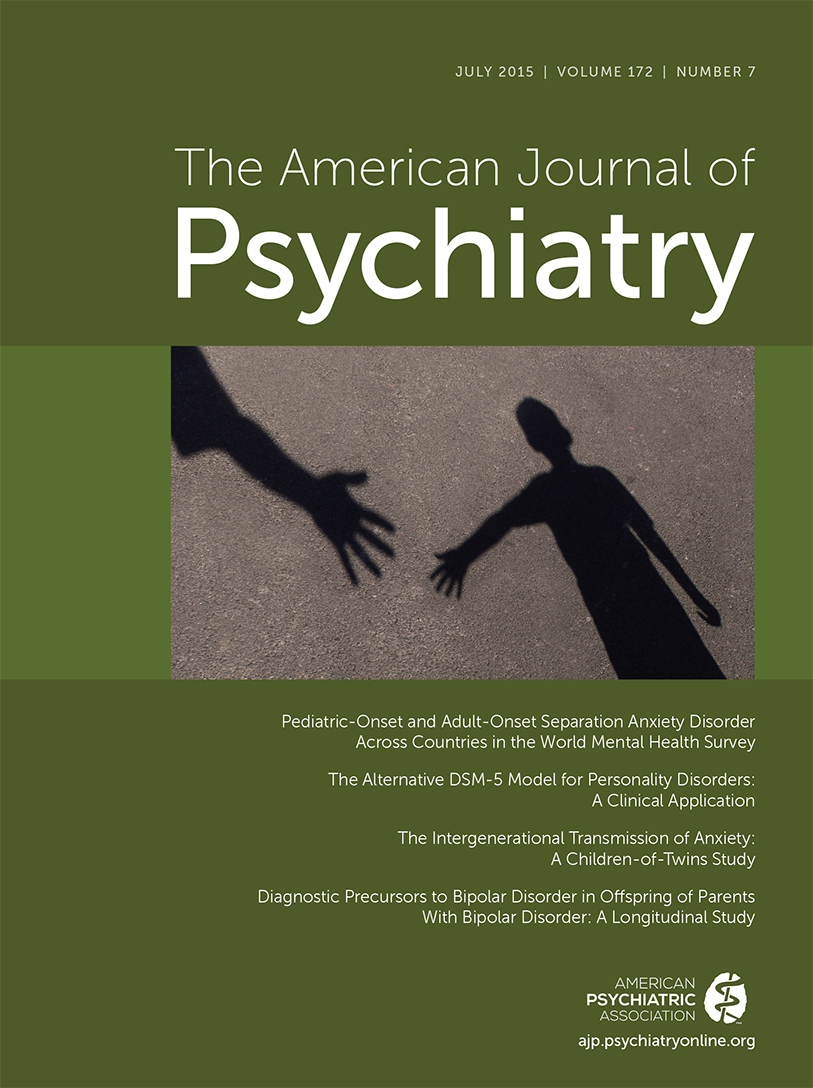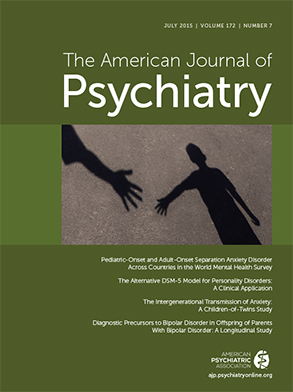In child mental health, irritability is everywhere and nowhere at once. Irritability is the most common reason children are brought for psychiatric evaluation (>40% of emergency department cases; >20% of outpatients [
1–
3]). Irritability is an explicit diagnostic criterion or associated symptom for multiple DSM diagnoses affecting children and adults, including mania in bipolar disorder, generalized anxiety disorder, attention deficit hyperactivity disorder (ADHD), oppositional defiant disorder, autism spectrum disorder (ASD), and the new DSM-5 disruptive mood dysregulation disorder (DMDD), plus child-specific modifications to the major depressive episode criteria. Irritability is linked to significant impairment in adulthood, including academic problems, poverty, psychopathology, and suicidality (
4–
6).
Yet there is no reliable marker, measure, or test to help clinicians determine which diagnosis (or diagnoses) involving irritability an individual patient has or which treatment for irritability would work best. Indeed, the lack of such biomarkers is one factor contributing to the overdiagnosis or misdiagnosis of these conditions. For example, up to 20% of children discharged from psychiatric hospitalization are diagnosed with bipolar disorder (
7); rates of children with ASD increased 78% from 2002 to 2008, accounting for 1 of every 88 children (
8); and 28% more children were medicated for ADHD in 2011 than in 2007 (
9). There is a clear need to get somewhere along the path toward a greater biological understanding of irritability across the lifespan.
The study reported by Roberson-Nay et al. in this issue of the
Journal (
10) is an important step on that path. This study examined the temporal pattern of genetic and environmental effects of irritability. To achieve this goal, the investigators harnessed data from the Swedish Twin Study of Children and Adolescent Development, which assessed twins in four waves between ages 8 and 20 (wave 1, ages 8–9; wave 2, ages 13–14; wave 3, ages 16–17; and wave 4, ages 19–20). Altogether, 1,310 twin pairs participated, including 267 female/female monozygotic, 199 female/female dizygotic, 254 male/male monozygotic, 182 male/male dizygotic, and 408 opposite-sex dizygotic twin pairs. Irritability was assessed using the parent-completed Child Behavior Checklist and the twin-completed Youth Self-Report (at waves 2 and 3) and the Adult Behavior Checklist (at wave 4).
The study demonstrated that the genetic effects on irritability are strong, are developmentally dynamic from middle childhood through young adulthood, and are associated with distinct patterns in males and females. In males, genetic influences on irritability increased with age, while nonshared environmental influences weakened. In contrast, in females, genetic influences on irritability were initially strong, and then declined with age, while nonshared environmental influences were stable throughout development. Notably, shared environment was not a primary influence on irritability for males or females, accounting for only 1%−5% of the variability.
This study is significant because it moves us closer toward the goal of identifying biobehavioral markers of irritability. From a psychopathology perspective, it suggests biologically determined trajectories of irritability that could improve our classification and diagnosis of irritability. From a treatment perspective, it suggests developmentally salient periods that might be ripe for targeted treatments. The study also serves as a response to a call, made during a 2014 conference sponsored by the National Institute of Mental Health (NIMH), for more research on the biological underpinnings of irritability.
How do we get to a point where such biobehavioral markers augment clinicians’ work with actual patients? Yogi Berra provided important guidance for this journey: “You’ve got to be very careful if you don’t know where you’re going, because you might not get there.”
It would be both easy and unfortunate if we gave up on this journey because researching irritability, particularly in children, is complicated. The greatest issue is the lack of a well-accepted definition of irritability. While most clinicians know irritability when they see it (to paraphrase Justice Potter Stewart), we lack consensus about what irritability is and how to differentiate pathological irritability from typical development, or irritability in one disorder from in another.
Thanks to work testing potential definitions during the past decade, we are further along the path. Among these efforts include the work of Ellen Leibenluft, M.D. (a coauthor on the Roberson-Nay et al.) in relation to children with primary mood disorders. Dr. Leibenluft employed a neuroscience definition of irritability as “markedly increased reactivity to negative emotional stimuli that is manifest verbally or behaviorally” (
11, Figure 4) to facilitate research comparing children with chronic irritability and hyperarousal (“severe mood dysregulation”) to those with distinct episodes of euphoric mania (“narrow phenotype bipolar disorder”) (
11). The resultant body of work showing distinctions between youths with severe mood dysregulation and those with narrow phenotype bipolar disorder resulted in DMDD being included as a new disorder in DSM-5.
Another example from children with externalizing behavioral disorders showed that oppositional defiant disorder has a tripartite factor structure, including “irritable/negative mood,” “spiteful/vindictive,” and “headstrong/defiant,” with only the “irritable” or “negative mood” factor (e.g., easy annoyance, frequent anger/temper outbursts) predicting subsequent emotional disorders (
12,
13). Building on this, Argyris Stringaris, M.D., has developed a six-question parent and child questionnaire, the Affective Reactivity Index (
14), to assess the irritable dimension of oppositional defiant disorder that is now being employed in diverse avenues of research, including longitudinal, neuroimaging, and genetic studies.
A third example emanates from NIMH’s Research Domain Criteria (RDoC) project, which seeks to develop, for research purposes, new ways of classifying mental disorders based on behavioral dimensions and neurobiological measures. “Frustrative nonreward” is a negative valence RDoC construct defined as “reactions elicited in response to withdrawal or prevention of reward.” Frustrative nonreward is linked to irritability via Blair’s somatic marker hypothesis, which posits that children less able to adapt to social rewards (e.g., praise or reprimand from parents or peers) may feel frustrated (defined as “affective response to blocked goal attainment”) and show symptoms of irritability and aggression (
14).
Further progress on this journey requires exploring new directions. More work is needed to identify different symptom patterns of irritability, including ways to measure the severity, temporal fluctuation, and associated features. We need to understand how these patterns of irritability are affected by development, puberty, and sex, and also how to assess them with ethno-racial and cultural sensitivity. While some of this work will involve questionnaires and interviews, we need to harness new technologies, including smartphone apps and mining of large electronic medical databases. We need new techniques to elicit and measure irritability at the behavioral and neurocircuitry level. This work will likely need dimensional approaches, with samples drawn across the range of functional impairment (i.e., psychiatric inpatients and outpatients and children not requiring treatment), and categorical approaches (i.e., comparing those with different disorders). Far from a fishing expedition, with no single definition or measure of irritability, this “journey to somewhere” will require both planful “next-step” research—building on some prior work—and some “bold steps”—using blind empiricism to compare how multiple different symptom-level measures of irritability carve the circuit/behavior/genetic assessments at their biological joints. Like many journeys, walking this path will require courage and risk taking from researchers and funders.
Ultimately, at the end of this journey lies a reward better than a pot of gold: a precision-medicine approach to irritability. From this terminus, clinicians can use cutting-edge biobehavioral markers for better (earlier, more specific) diagnosis of patients suffering from irritability. They can also develop new treatments for irritability, including medications, psychotherapies, and cognitive remediation, because the only current Food and Drug Administration indication for pediatric irritability is for atypical antipsychotics—and that in children with autism (
14). Together, we will get somewhere, for our patients’ sake.

